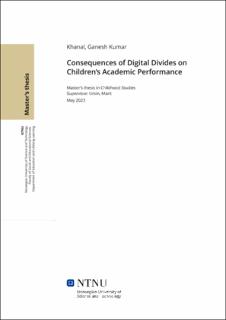| dc.description.abstract | Abstract
The global pandemic of novel coronavirus affected teaching-learning in schools for several months during 2020-2022. On one hand, this showcased preexisting socio-economic and digital inequalities across schools, communities, and regions, and on the other, increased children’s participation in different digital environments. The evidence shows the First Digital Divide – inequality in digital access – is decreasing globally while the Second Digital Divide – inequality in skills and usage – is rampant among children in different contexts. This means that children’s digital use is not homogenous, despite the universal identity of Digital Natives, Net-gen, or Z-gen. This heterogeneity in digital use has created the Third Digital Divide – inequality in outcomes – which again has profound social consequences beyond children’s learning and well-being. This study examines this heterogeneity in digital use and its impacts on children’s academic outcomes in Global North and South schools, which are explored in global research published between 2000 and 2020.
Using socio-material perspectives and notions of the ANT (Callon & Latour, 1981; Latour, 2005; Law, 1992) and a systematic review methodology, I synthesize 62 studies exploring dynamic relationships between the digital divide(s) and children’s academic outcomes. Furthermore, I employ those analytical concepts to unpack various social and material aspects, called actants (e.g., family social, cultural and economic capitals, digital technology, learning spaces, platforms, materials, etc.), which seem to mediate the heterogeneous use of digital technology and create different academic outcomes.
The review suggests that children from disadvantaged families use digital technologies, mostly, for non-educational purposes, while their privileged counterparts employ similar platforms for information and learning. This is because the assemblages of heterogenous materials, consisting of both human and non-human resources, aggregate to help the privileged children successfully translate those means into academic achievements. These findings show that the “academic agency” is produced by heterogeneous materials rather than an individual child. Available empirical evidence supports this argument because academically poor-performing learners improved both academic and non-academic outcomes following the effective implementation and use of digital technologies. This warrants a shift in the understanding of academic performance purely as the cognitive ability to the outcomes of assemblages capitalized on children by themselves and others at their disposal. I conclude the study by suggesting that the socio-material perspective is compelling to integrate heterogeneous materials into our analysis, providing critical insights into matters that produce academic inequalities. This is significant for the field of Childhood Studies because children’s learning experiences affect their development and well-being, which have profound consequences for neoliberal schooling and society. Thus, any effort towards improving children’s learning experiences and outcomes needs to concentrate on the quality and sustainability of the assemblages in which children are embedded, which means providing children with ubiquitous access to digital technology is necessary but not sufficient condition to improve learning and well-being. | |
